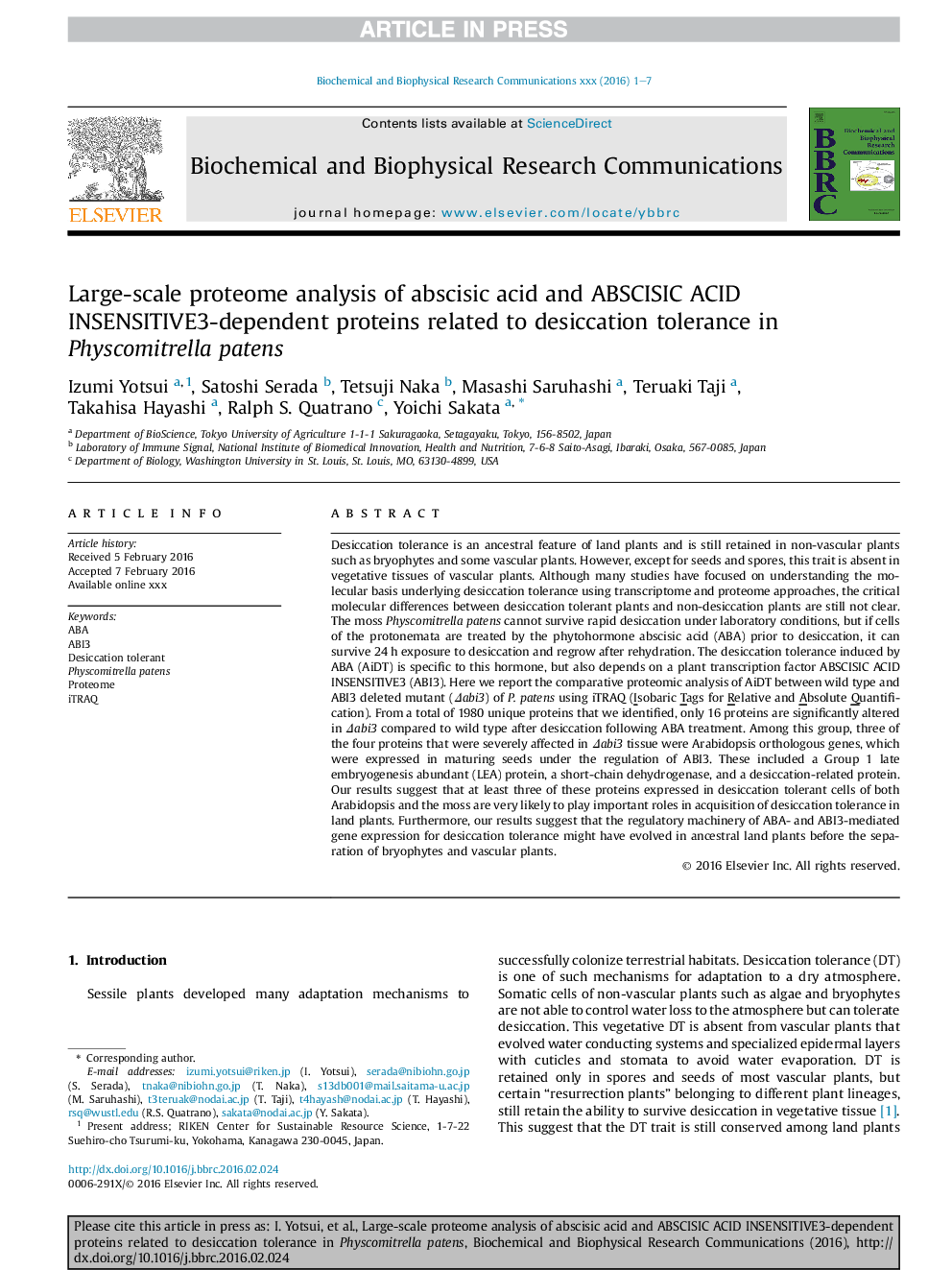| کد مقاله | کد نشریه | سال انتشار | مقاله انگلیسی | نسخه تمام متن |
|---|---|---|---|---|
| 10748348 | 1050271 | 2016 | 7 صفحه PDF | دانلود رایگان |
عنوان انگلیسی مقاله ISI
Large-scale proteome analysis of abscisic acid and ABSCISIC ACID INSENSITIVE3-dependent proteins related to desiccation tolerance in Physcomitrella patens
ترجمه فارسی عنوان
تجزیه و تحلیل پروتئوم در مقیاس بزرگ پروتئین های وابسته به اسید واکنش پذیر و وابسته به اسید بنزن حساس به وابسته به تحمل خشکی در پاتوژن های فیزیکومترلا
دانلود مقاله + سفارش ترجمه
دانلود مقاله ISI انگلیسی
رایگان برای ایرانیان
موضوعات مرتبط
علوم زیستی و بیوفناوری
بیوشیمی، ژنتیک و زیست شناسی مولکولی
زیست شیمی
چکیده انگلیسی
Desiccation tolerance is an ancestral feature of land plants and is still retained in non-vascular plants such as bryophytes and some vascular plants. However, except for seeds and spores, this trait is absent in vegetative tissues of vascular plants. Although many studies have focused on understanding the molecular basis underlying desiccation tolerance using transcriptome and proteome approaches, the critical molecular differences between desiccation tolerant plants and non-desiccation plants are still not clear. The moss Physcomitrella patens cannot survive rapid desiccation under laboratory conditions, but if cells of the protonemata are treated by the phytohormone abscisic acid (ABA) prior to desiccation, it can survive 24 h exposure to desiccation and regrow after rehydration. The desiccation tolerance induced by ABA (AiDT) is specific to this hormone, but also depends on a plant transcription factor ABSCISIC ACID INSENSITIVE3 (ABI3). Here we report the comparative proteomic analysis of AiDT between wild type and ABI3 deleted mutant (Îabi3) of P. patens using iTRAQ (Isobaric Tags for Relative and Absolute Quantification). From a total of 1980 unique proteins that we identified, only 16 proteins are significantly altered in Îabi3 compared to wild type after desiccation following ABA treatment. Among this group, three of the four proteins that were severely affected in Îabi3 tissue were Arabidopsis orthologous genes, which were expressed in maturing seeds under the regulation of ABI3. These included a Group 1 late embryogenesis abundant (LEA) protein, a short-chain dehydrogenase, and a desiccation-related protein. Our results suggest that at least three of these proteins expressed in desiccation tolerant cells of both Arabidopsis and the moss are very likely to play important roles in acquisition of desiccation tolerance in land plants. Furthermore, our results suggest that the regulatory machinery of ABA- and ABI3-mediated gene expression for desiccation tolerance might have evolved in ancestral land plants before the separation of bryophytes and vascular plants.
ناشر
Database: Elsevier - ScienceDirect (ساینس دایرکت)
Journal: Biochemical and Biophysical Research Communications - Volume 471, Issue 4, 18 March 2016, Pages 589-595
Journal: Biochemical and Biophysical Research Communications - Volume 471, Issue 4, 18 March 2016, Pages 589-595
نویسندگان
Izumi Yotsui, Satoshi Serada, Tetsuji Naka, Masashi Saruhashi, Teruaki Taji, Takahisa Hayashi, Ralph S. Quatrano, Yoichi Sakata,
